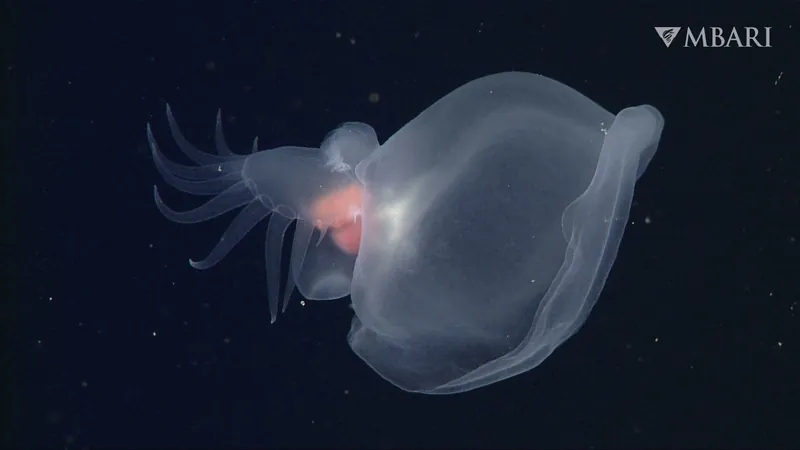
Meet the Glow-in-the-Dark Mystery Mollusk: A New Deep-Sea Discovery That Will Blow Your Mind!
2024-11-12
Author: Olivia
Groundbreaking Discovery
In a groundbreaking discovery, the Monterey Bay Aquarium Research Institute (MBARI) has identified a stunning new species of sea slug, scientifically termed Bathydevius caudactylus, that thrives in the mysterious depths of the ocean, known as the midnight zone. This fascinating creature, aptly nicknamed the “mystery mollusk,” possesses a remarkable gelatinous hood and a paddle-like tail, lighting up the waters with its brilliant bioluminescence. The detailed findings have been published in the prestigious journal, Deep-Sea Research Part I.
The Journey of Discovery
Senior Scientist Bruce Robison, who has devoted over 20 years to studying this enigmatic nudibranch, stated, "Our research with MBARI's cutting-edge underwater technology allows us to describe deep-sea life like never before, revealing crucial insights about the largest habitat on Earth."
The journey to uncover the mystery mollusk began in February 2000 during a dive off the coast of Monterey Bay, where MBARI's remotely operated vehicle (ROV), Tiburon, descended to an astonishing depth of 2,614 meters (8,576 feet). After closely examining over 150 sightings captured by MBARI's ROVs throughout the years, researchers finally pieced together a comprehensive profile of this extraordinary animal.
Unique Adaptations for Survival
What makes the mystery mollusk truly extraordinary is its unique adaptation for survival in the ocean's depths. Unlike most nudibranchs that reside closer to the seafloor, Bathydevius caudactylus occupies the bathypelagic zone, which stretches between 1,000 to 4,000 meters (3,300 to 13,100 feet) beneath the surface. Its bioluminescent abilities serve as both a means of communication and a defense mechanism against predators. In a moment of danger, it can emit light to distract attackers or even detach a glowing part of its body, akin to how some lizards drop their tails.
Mesmerizing Behavior and Feeding
The researchers believe that bioluminescence is a result of convergent evolution in the deep-sea ecosystem, which has only been noted in a limited number of nudibranch species. “When we first filmed it glowing with the ROV, the entire team was mesmerized. It was a sight to behold,” recalled MBARI Senior Scientist Steven Haddock.
This mesmerizing creature feeds in a unique way, using its cavernous hood to trap prey, particularly crustaceans, in a manner reminiscent of a Venus flytrap. With the ability to flex its entire body, the mystery mollusk navigates through the water column with grace, either swimming actively or drifting effortlessly.
Reproductive Strategy
What's even more astounding is the mystery mollusk's reproductive strategy. It is a hermaphrodite, possessing both male and female sex organs, and descends to the ocean floor to spawn. One of the specimens observed even released a ribbon of eggs in the lab, showing the species' ability to reproduce at great depths.
Importance of Deep-Sea Exploration
Research indicates this remarkable nudibranch may not be alone, as a similar-looking animal spotted in the Mariana Trench hints at a potentially broader geographic range for the species.
Booming discoveries such as the mystery mollusk emphasize the importance of deep-sea exploration. The MBARI team has documented over 250 previously unknown deep-sea species, revealing the rich biodiversity beneath the ocean's surface. “Every new discovery offers a glimpse into the untold mysteries of the deep sea, encouraging us to protect these incredible creatures and their environments,” Robison added.
Conclusion
For those captivated by ocean life, the discovery of Bathydevius caudactylus serves as a reminder of the wonders that still lie hidden in the depths—and why we must continue to explore and safeguard our blue planet!
Call to Action
Have questions or thoughts about this amazing discovery? Comment below and join the conversation about our ocean's secrets!









 Brasil (PT)
Brasil (PT)
 Canada (EN)
Canada (EN)
 Chile (ES)
Chile (ES)
 España (ES)
España (ES)
 France (FR)
France (FR)
 Hong Kong (EN)
Hong Kong (EN)
 Italia (IT)
Italia (IT)
 日本 (JA)
日本 (JA)
 Magyarország (HU)
Magyarország (HU)
 Norge (NO)
Norge (NO)
 Polska (PL)
Polska (PL)
 Schweiz (DE)
Schweiz (DE)
 Singapore (EN)
Singapore (EN)
 Sverige (SV)
Sverige (SV)
 Suomi (FI)
Suomi (FI)
 Türkiye (TR)
Türkiye (TR)